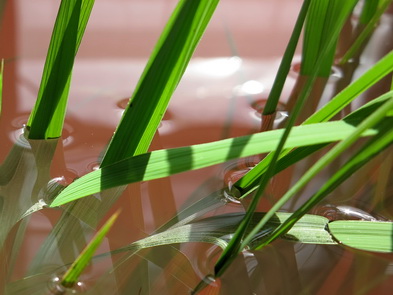Flood and drought tolerance – one gene to rule them all
A newly discovered gene in rice confers flood tolerance, drought tolerance and disease resistance, and the discovery of the gene is a major step forward on the quest to produce climate smart crops. The gene, LGF1, is involved in the wax synthesis and controls the nano-structure of leaf surfaces. During flood events, the gene enables survival of submerged rice since the wax nano-structures retain a thin Leaf Gas Film; hence the name of the gene, LGF1. The gas films facilitate gas exchange with the floodwater so that carbon dioxide can be taken up during the daytime in order to fuel underwater photosynthesis and at night-time oxygen can be extracted so that aerobic respiration is maintained. LGF1 gene also confers drought tolerance since the tiny wax crystals reduce evaporation from the leaf surfaces and thus tissue water is conserved. Finally, the nano structures of the wax layer render the surface superhydrophobic and hence the leaf repels water. During rain, the shedding of water removes dust particles and spores of pathogenic fungi and bacteria.

The superhydrophobic properties of rice leaves is controlled by only gene, LGF1.
An international collaboration between researchers at the University of Copenhagen, Nagoya University and the University of Western Australia has resulted in a breakthrough in plant biology. Since 2014, our team of researchers has worked on identifying the genetic background for the improved flood tolerance observed in rice, wheat and several natural wetland plants. In the current issue of the New Phytologist, we summarize the research effort in an article that describes the discovery of a single gene that controls the surface properties of rice rendering these superhydrophobic. It has been known for almost a decade that superhydrophobic leaves greatly enhance flood tolerance of plants but the genes coding for these properties had not been identified.
Superhydrophobic surfaces retain a thin gas film when under water, and the gas film enables the stomata to function also during submergence. The stomata regulate the uptake of CO2 (carbon dioxide) for photosynthesis during the day but also the uptake of O2 (oxygen) during darkness so that aerobic respiration is enables. Without the protective layer of gas, the floodwater blocks the stomata and the gas exchange with the environment is greatly restricted; the plants are virtually drowning!
We have used advanced microelectrodes both in controlled laboratory experiments and in the field situation to reveal the huge benefits of leaf gas films during submergence. Plants living on the coast can face complete submergence twice each day, and we have shown that without the superhydrophobic leaves Common Cordgrass would not be able to live in the intertidal zone where it forms vast populations in Europe and North America. We have also assessed the importance of leaf gas films during submergence of rice, and in some situations rice grows equally well above as well as below water – only because rice possesses the LGF1 gene.
Worldwide, climate changes have already resulted in an increased number of floods and in order to sustain food supply in a wetter future, we need climate-smart crops that better tolerate flooding. Unfortunately, the superhydrophobic leaf properties that are coded by the LGF1 gene is lost with time of submergence, i.e. after a week or so, the leaves become wet, the stomata floods and the plants are drowning. Thus, our research now focuses on overexpression of the LGF1 gene since we believe that a reduced expression of the gene during submergence is responsible for the loss of hydrophobicity over time. Fortunately, there is an excellent track record within the research of improved flood tolerance of rice and we thus optimistic that we can help advancing the breeding efforts, which could also be translated into wheat since wheat shares the leaf properties with rice. The fact that it is all controlled by just a single gene makes achieving this ambitious goal much more realistic!
